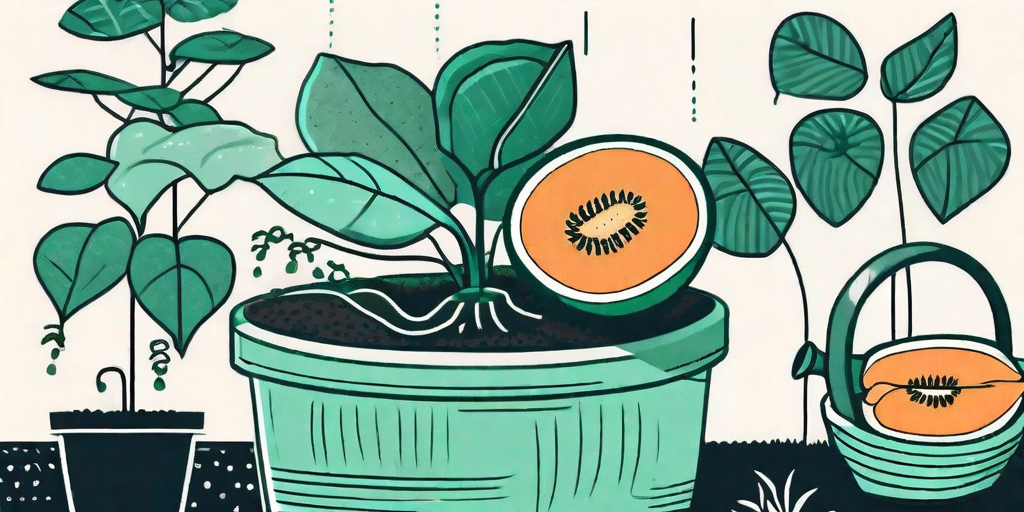
Welcome to the world of container gardening, where the only thing juicier than the gossip is the cantaloupes. If you've ever dreamed of growing your own cantaloupes but thought you needed a sprawling garden to do so, then buckle up, because we're about to take a wild ride into the realm of container gardening.
Why Cantaloupes in Containers?
Before we dive into the "how", let's address the "why". Why on earth would anyone want to grow cantaloupes in containers? Well, for starters, not everyone has the luxury of a large garden. Some of us are apartment dwellers with nothing more than a sunny balcony. But that doesn't mean we can't enjoy the sweet satisfaction of biting into a cantaloupe we've grown ourselves.
Secondly, growing cantaloupes in containers allows for better control over the growing conditions. You can move your cantaloupe plant to follow the sun, or bring it indoors if the weather turns nasty. Plus, it's a great way to impress your friends and neighbors. "Oh, this cantaloupe? I grew it myself. In a container. No big deal."
Choosing the Right Container
Now that we've established why you should grow cantaloupes in containers, let's talk about the container itself. Not all containers are created equal, and the right one can make all the difference between a cantaloupe catastrophe and a cantaloupe triumph.
Firstly, size matters. Cantaloupes are not small plants, and they need room to grow. A container that's at least 18 inches deep and 24 inches wide is a good starting point. Secondly, the material of the container can also play a role. Plastic containers are lightweight and easy to move, but they can also heat up in the sun, which can be detrimental to your cantaloupe plant. Clay or ceramic pots, on the other hand, are heavier but provide better insulation against heat.
Drainage is Key
Regardless of the size or material of your container, one thing is non-negotiable: good drainage. Cantaloupes do not like wet feet, and a container that doesn't drain well is a recipe for root rot. So make sure your container has plenty of drainage holes, and consider adding a layer of gravel or broken pottery at the bottom to improve drainage even further.
Planting Your Cantaloupe
Now that you've chosen your container, it's time to get planting. But before you start throwing seeds around willy-nilly, there are a few things to consider.
Firstly, cantaloupes like warm soil. This means you should wait until the danger of frost has passed before planting your seeds. If you're eager to get a head start, you can start your seeds indoors and transplant them once the weather warms up.
Secondly, cantaloupes are heavy feeders. This means they need a lot of nutrients to grow. A good quality potting mix enriched with compost or well-rotted manure will give your cantaloupe plant the best start in life.
Seed Spacing and Depth
When it comes to planting your seeds, spacing and depth are important. Cantaloupes need room to grow, so plant your seeds about 12 inches apart. As for depth, aim for about 1 inch deep. Any deeper and your seeds may struggle to germinate.
Caring for Your Cantaloupe
Now that your cantaloupe plant is in its container, it's time to switch to caregiver mode. This involves watering, feeding, and generally keeping an eye on your plant to ensure it's growing happily.
Watering is crucial. Cantaloupes need a lot of water, but they don't like to be waterlogged. The key is to water deeply but infrequently. Wait until the top inch of soil is dry before watering again.
Feeding your cantaloupe is also important. A slow-release fertilizer applied at planting time will provide your plant with the nutrients it needs to grow. But remember, too much of a good thing can be harmful, so don't overdo it with the fertilizer.
Dealing with Pests and Diseases
Unfortunately, cantaloupes are not immune to pests and diseases. Aphids, cucumber beetles, and powdery mildew are just a few of the potential problems you might encounter. The key is to catch these issues early and deal with them promptly. Regularly inspect your plant for signs of trouble, and don't be afraid to enlist the help of a good insecticidal soap or fungicide if needed.
Harvesting Your Cantaloupe
After all your hard work, the moment of truth has arrived: it's time to harvest your cantaloupe. But how do you know when it's ready? Well, there are a few telltale signs.
Firstly, the color of the cantaloupe will change from green to a creamy yellow. Secondly, the cantaloupe will start to smell sweet and fruity. And finally, the stem will start to crack and the cantaloupe will easily separate from the vine. If all these signs are present, congratulations, you've successfully grown a cantaloupe in a container!
FAQs
Can I grow cantaloupes in containers indoors?
Yes, you can grow cantaloupes in containers indoors, provided you have a sunny spot for them. They need at least 6 hours of sunlight a day to grow well.
What is the best variety of cantaloupe to grow in containers?
Compact varieties like 'Minnesota Midget' and 'Bush Sugar Baby' are well-suited to container gardening.
Can I grow other melons in containers?
Yes, many types of melons can be grown in containers, including watermelons and honeydew melons.
So there you have it, the juicy secrets to growing cantaloupes in containers. Now go forth and grow some melons!











